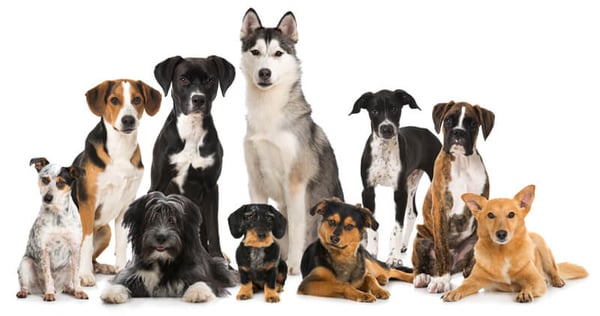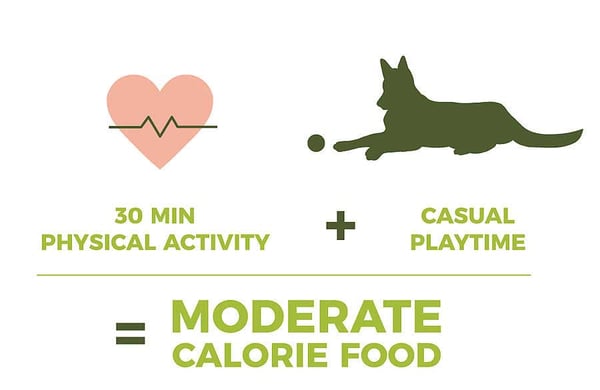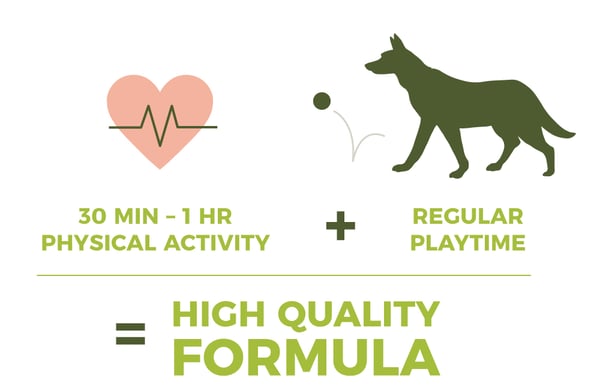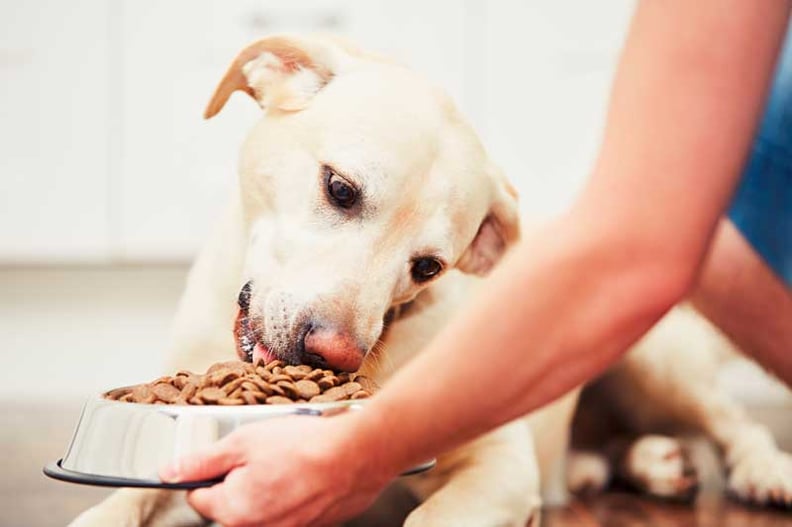
Every dog is different, and its nutritional needs reflect that. Dogs come in all shapes and sizes, from two-pound teacup chihuahuas to two-hundred-pound mastiffs, and all of them have unique dietary requirements.
There are many brands of food that are labeled as puppy food, but that doesn't make them the right fit for every puppy. Without looking into some of the specific needs of your pet, you could end up feeding a food that simply doesn't meet their needs.
Check out How to Read and Understand Pet Food Labels for more information on how to decipher the pet industry's marketing lingo.
It’s important to consider these factors when choosing the type of food that your dog needs:
- Size
- Breed
- Activity Level
- Anxiety
It is also necessary to look at more than just ingredients. This blog will help you determine what nutritional category your dog falls into and what type of food may best suit them.
Size Does Matter
It's easy to assume that dogs are dogs, and they should all require the same nutrients, but that's simply not the case. While multiple factors come into play, size is probably to most overlooked.
It's easy to point out the obvious differences in foods for different size categories, like kibble size, but the formulas can often be quite different. Calorie content, protein and fat levels, and quantities of vital minerals and vitamins should all be taken into account based on the size of your pooch.
Dietary Needs of Small Breeds

For many small breed dog owners, it's easy to see that these dogs eat, play, and grow differently than larger breeds. Of course, we consider things like kibble size to match their small compact mouths, but there are more things to consider than that. Many small breeds are prone to preventable ailments that could be avoided by an appropriate diet.
Higher Metabolic Rate
Small breeds often require more nutrient-dense foods because of their higher metabolic rate. A higher metabolic rate can burn through calories and energy quicker and will require your small breed dog to eat a more calorie-dense diet to maintain their muscle mass and activity levels, especially during growth stages.
Young puppies should be fed three to four meals a day to avoid the risk of hypoglycemia, or low blood sugar, caused by the dog’s faster metabolism. Even during maintenance stages, or adulthood, many small breeds still require slightly elevated calorie levels in their diet. How to find the right food for your dog?
Obesity is very common in small breed dogs, as many of them are indoor pets with very low activity levels. For pocket puppies with sedentary lifestyles, you must be very careful of how many, and where the calories come from to avoid weight issues.
Foods with high-quality protein and fat levels, along with minimal and low-glycemic carbohydrate sources, will maintain a healthy weight and still support a faster metabolic rate.
Free feeding is a common practice amongst small breed owners. This method is useful for training your dog to regulate its own calorie intake. Offer food at regularly scheduled intervals; two a day is average or three to four for young puppies.
Instead of portioning out their food, just let your dog eat until they're full, within reason of course. Always monitor your dog during mealtime to avoid them over-eating and gorging themselves. When your dog is finished, take away the food and do not offer it again until the next scheduled feeding.
Although it can take some time to properly transition to this method, many dogs can achieve a healthy weight and muscle mass using their own natural animal instincts.
For dogs who insist on ever-eating, portion control may be necessary to maintain an appropriate weight.
Check out How Much Should I Feed my Dog for more information on your dog's weight and feeding guidelines, or try our choosing dog food calorie calculator.
Antioxidants Protect Against the Effects of Aging
The average life expectancy of a small breed dog is 5-7 years longer than that of larger breed dogs. Since so much of your small breed dog’s life is between adult and senior years, it’s no surprise that they are afflicted with more of the damaging effects of aging, like cell damage, diminished cellular regeneration, and reduced immune system function. How to find the best food for your dog?
Providing a diet rich in antioxidants can protect against age-related cell damage. Look for natural sources of vitamin A, C, and E in your pet’s diet, from broccoli, spinach, squash, and many fruits to protect your small dog from degenerative senior ailments. Fresh produce can also be fed as treats or meal toppers.
Supplements like Krill oil can also be a very effective source of anti-oxidants.
Dietary Needs of Medium to Large Breeds

Growth rate effects on the skeletal structure
Large and giant breed dogs have a lot of growing to do throughout their adolescence and this puts a greater strain on their muscle and skeletal structure to support the weight. Therefore, high-quality proteins are vital to prevent joint and mobility issues.
To properly support bone structure, an appropriate mix of both phosphorous and calcium is required. The recommended ratio of Calcium to Phosphorus is 1.2:1.
Phosphorus is abundantly found in high-quality meat and organ tissue and is more readily available in the average commercial diet. Calcium requirements of large and growing breeds are greater, so foods catering to large breed dietary requirements are recommended. Calcium can also be supplemented from natural sources like eggshells or raw bones. Choosing the right food for your dog?
The best protein source for both is found in whole prey diets. Whole prey diets incorporate healthy meat, organ tissue, bone, ligaments, tendons, and cartilage, all of which provide the ideal balance of phosphorus and calcium.
Supplements
Many premium foods include added supplements to support joint and mobility health. Cartilage, ligaments, and tendons are all made up of fibrous tissue called collagen.
Glucosamine sulfate is a precursor to collagen production. Glucosamine is sourced mainly from shellfish, but can also be found in fermented grains such as corn or wheat. Almost any joint support supplement will have glucosamine as the active ingredient required to assist in joint health and recovery as it repairs and protects tendons, ligaments, and connective tissues.
While the quantities offered in pet food look significant and can provide some maintenance, they are not enough to offer therapeutic support. Cooking processes can degrade the quality and bioavailability of the supplements making them ineffective or insignificant.
For complete joint and mobility health, feed your dog high-quality foods and administer additional supplements from natural sources. Powdered, liquid, and pill supplements are most often sourced from shellfish as it is the most abundant source.
Other commonly found supportive supplements for joint health are Chondroitin Sulfate, also known as Shark cartilage, and Methylsulfonylmethane, MSM.
Chondroitin Sulfate is an important component of cartilage. It maintains the structural integrity of the collagen tissue and protects it from constant compression. Chondroitin is naturally sourced in cartilage, from a shark in particular.
MSM is a powerful anti-inflammatory. Reducing the swelling, or inflammation, in joint tissue relieves mobility problems and the pain associated with it.
Breed

All breeds have specific traits and anatomical differences, and often require different types of food. Always research your breed to get an idea of average size, weight, activity levels and genetic predisposition to conditions or diseases.
If you can, talk with your dog’s breeder about your pet’s family history. This will help you decide not only what kind of foods to feed your dog, but also how much and what changes to expect as they age.
Metabolic rates and genetic disorders are common in certain breeds. Knowing what your dog’s genetic predispositions are can help you choose a food and lifestyle that can prevent unnecessary vet bills and stress down the road.
Here are a few common examples:
Arthritis and Mobility Disorders
Although hip and joint issues are usually associated with large and giant breeds, small breeds can be prone to certain conditions as well. Patellar Luxations, or floating kneecaps, are most common in small breeds like Chihuahuas, Boston Terriers, and French Bulldogs.
It's especially important to maintain muscle mass and healthy weight in any breed that is predisposed to hip and joint conditions. Excess weight can strain the affected joints and connective tissues, and limiting muscle mass provide little support for joint function.
Bladder Stones and Urinary Tract Problems
Although this is less common, chronic kidney and urinary tract problems can be seen in certain breeds more than others. Dalmatians are a prime example. Most Dalmatians require very specific diets to prevent kidney and urinary issues.
Finding a food that will support muscle mass, but limit purines, a trigger for dogs prone to urinary tract and kidney infection, is challenging, but acting preventatively will save you money on vet bills and save your dog the pain and discomfort of kidney stones.
Activity Level
Understanding your dog's activity level will help you make the best dietary decision for them. It's easy to mistake your dog's activity levels and assume your pet is using more calories than they are. Here's a helpful guide for ranking your pet's activity level.
Low activity

Low activity would consist of 30 minutes or less of vigorous physical activity, plus casual playtime throughout the day. Although weight and size may indicate higher calorie intake, recommended feeding guidelines will be excessive and do not factor in the dog’s low activity levels.
When puppies are gaining weight but not muscle, this is a sign that they are being overfed and/or under stimulated, physically.
Look for moderate calorie foods with a mix of good high-quality proteins and low glycemic vegetables and whole grains to provide long-term energy that won’t affect blood glucose levels. Avoid excessive grains to prevent unused carbs from accumulating as fat in the body.
Check out Weight Loss Dog Food for more information on how to find the best food for your pudgy pet.
Moderate Activity

At least 30 minutes to an hour of vigorous physical activity, plus regular playtime throughout the day, and interactive mental stimulation.
Most high-quality dog formulas would be perfect for these breeds. Look for low-glycemic, high-quality proteins to build muscle mass and support increased activity levels.
Moderate activity levels are typically the basis for most feeding recommendations, so try starting with those and adjust as you need to.
High Activity

These breeds are loaded with energy and must be run or walked for more than an hour per day, along with regular playtime throughout the day.
Lots of playtime and training will help boost their metabolism, helping them process and utilize high calories to build and maintain muscle mass. Mental stimulation will decrease boredom and improve eating habits.
High protein, grain-free, whole-prey formulas are best for these breeds to provide long-term energy to support their active lifestyles. These breeds will often need to be fed a more calorie-dense diet, supplemental nutritional aids or be provided with increased feeding portions to prevent weight or muscle loss.
Is your dog getting enough exercise? Check out this Exercise Calculator to see if your dog is as active as he should be.
Boredom and Anxiety
Although dogs can, and in some cases do, sit around like couch potatoes, it is actually in their nature to be more active and productive than we sometimes realize. Dogs of all life stages love having a sense of purpose as well as the mental and physical stimulation that it provides.
Engaging in one-on-one interactive playtime does not have to be strenuous. Playing games like hide and seek are simple and keep your dog’s mind active and curb boredom while reducing anxiety and strengthening your bond.
Mental activity is just as important as physical activity. In addition to regular exercise routines, offer interactive toys and mind games during downtime and alone time to avoid poor eating habits related to anxiety and boredom.
You may need to reduce portions, change your feeding schedule or look for a lower calorie food for pets that are happy being couch potatoes, but these changes still should be accompanied by an increase in either mental or physical stimulation.
Try to avoid foods with heavy fillers and sugars, and have a moderate amount of fat and protein to help reduce unused calories and build muscle mass. Over time, your pet will leave his lazy habits behind and enjoy the increased activity.
Narrowing Down Your Options

Pet stores can carry an overwhelming selection of raw dog foods. Don't stress!
The great news is that there are dozens of foods that are probably perfect for your dog. Our goal is not to find the one food to feed them all but to find a food that helps your dog thrive.
Don't be discouraged if you try a food and it's just not working out. You may need to try a couple of brands before you find the one the is just right for both you and your dog.
During any diet change, you should monitor your dog's progress. Weight, activity level, skin and coat condition and stool quality can all help you determine if the food that you chose is working out.
You should be seeing consistency or improvement over time. Switching foods always runs the risk of minor digestive disruptions, but that should not persist after your dog is fully transitioned on to a new food.
To assess your dog's weight gain or loss, do a visual and touch assessment weekly. Some breeds, body types and sizes can be harder to judge based on sight and touch, so if possible weigh your dog regularly.
Frequently Asked Questions
What should I consider when choosing dog food?
When choosing dog food, consider your dog's age, size, activity level, and any specific health needs. Look for a food that offers balanced nutrition and meets their dietary requirements.
Is there a one-size-fits-all dog food?
No, there isn't a one-size-fits-all dog food. Different dogs have different nutritional needs.
What are the key nutrients my dog needs?
Dogs need a combination of proteins, fats, carbohydrates, vitamins, and minerals to thrive. Look for foods with high-quality protein sources, essential fatty acids, and a variety of premium nutrients.
Should I choose dry or wet dog food?
Both dry and wet dog foods have their advantages. Dry kibble is convenient and can help with dental health, while wet food provides hydration and can be a good option for dogs with dental issues.
How can I tell if a dog food is of good quality?
Look for dog foods with whole meat sources as the first ingredient, limited fillers, and minimal artificial additives.
Is it necessary to consult a veterinarian for food recommendations?
Consulting a veterinarian is highly recommended when selecting dog food. A vet can provide guidance based on your dog's unique needs, helping you choose the best food to support their health and well-being.
.png?width=200&height=66&name=logo%20(1).png)





.jpg)

